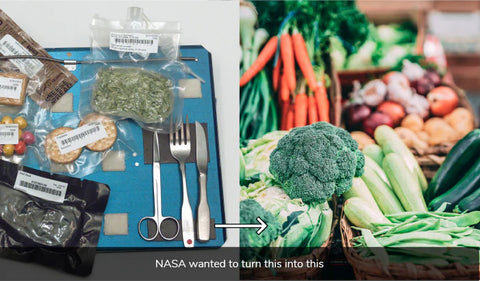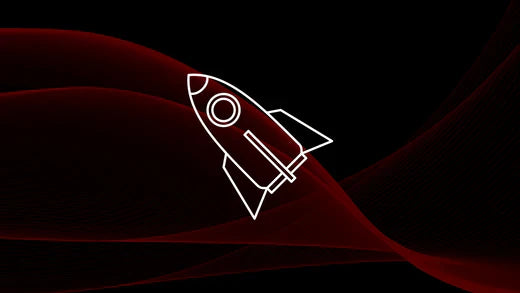In the 1980's, NASA started using red light therapy to stimulate plant growth in space.
They soon discovered that this treatment had therapeutic benefits for humans.
Today, that technology is used in red light therapy panels that are available for consumer use.
In the following sections, we explore how this discovery came about and evolved into an FDA registered treatment for healing.
Red Light Therapy at NASA: The Program's Origin
Life, whether plant or animal, does not thrive in space as it does on Earth. This presented a challenge for NASA scientists, who wanted to study plant growth in space as a way to feed astronauts on long-range space missions.
NASA knew that using traditional light sources was not an option because they were not adaptable to space flight. The main issues with traditional lighting include high heat output and huge energy demands.

LED lights were proposed as a viable option because they are energy-efficient and safe.
During the 1980s, NASA scientists began exploring space horticulture. They wanted to develop regenerative gardens that could survive extraterrestrial voyages. Red light therapy could potentially stimulate plant growth in microgravity environments.
NASA was also interested in growing plants in space to improve astronaut health, which was a prime concern during extended space missions. An important part of keeping astronauts healthy is having adequate supplies of nutritious food on long-term space voyages where resupply is limited or nonexistent.

Freeze-dried ‘space food’ was the norm during the heyday of space exploration in the 1960s and 1970s. Vegetables would be healthier and fresh. They would also be renewable food sources on the International Space Station. Pre-prepared meals, on the other hand, would have to be launched out of orbit, stored, and reconstituted with water.
Faced with this formidable challenge, NASA scientists needed to find a light source that consumed less energy, didn't generate as much heat, and provided the kind of light that was necessary for healthy plant growth. The solution was light-emitting diode bulbs, more commonly known as LEDs.
Here is a timeline of the events relevant to NASA:
|
1983 |
Tiina Karu releases a research paper speculating on the use of red light therapy for stimulating human healing. |
|
1985-1989 |
Engineer Robert Ignatius works on red light therapy research with the NASA-funded Wisconsin Center for Space Automation and Robotics (WCSAR). |
|
1989 |
NASA provides research funds to Quantum Devices Inc. for research on the use of red light therapy for stimulating plant growth. |
|
1995 |
NASA launches first red light therapy devices for use in orbit. |
|
1995-2003 |
NASA continues to contract with third parties to develop RLT technology. |
|
2007 |
WARP 10 RLT device is developed for military use. |
|
2012 |
PlatinumLED launches the first 12-spectrum RLT device for consumer use. |
LEDs: The Ideal Solution for Stimulating Plant Growth
Ronald W. Ignatius, founder, and chairman of Quantum Devices Inc. (QDI), was the first person to propose using an LED bulb for growing plants. The idea occurred to him during the late 1980s when plant growth experiments were being conducted at the NASA-sponsored Wisconsin Center for Space Automation and Robotics. LEDs, a NASA article explains, “provide high-energy efficiency and virtually no heat, despite releasing waves of light 10 times brighter than the Sun.”
The focus of the research was studying light sources for growing food; specifically, growing food indoors for environments like space shuttles and the International Space Station (ISS), where humans would be present for a long period of time. The NASA research team partnered with QDI to determine whether LEDs could provide the necessary light wavelengths and light intensity for photosynthesis to occur.
As the team hoped, LEDs boosted energy production in plant cells, which promoted growth and photosynthesis.

These first experiments showed great promise, even though the wheat grown aboard spacecraft was flawed. That finding prompted Ignatius to develop LED products that emit the exact wavelengths of light that plants need for photosynthesis.
NASA then created Astroculture3, a plant growth chamber that uses LEDs to grow plants aboard spacecraft. In October 1995, LEDs made their flight debut on the Space Shuttle Columbia, in the second U.S. Microgravity Laboratory Spacelab mission.
NASA Research on Red Light Therapy Throughout the Years
Like all technologies, LEDs have evolved throughout the years. Today’s LED lights are more powerful, release less heat, and can be fine-tuned to precise wavelengths that are perfectly optimized for plant and human health.
Since 2012, NASA’s Advanced Exploration Systems (AES) Habitation Projects at Kennedy Space Center’s Space Life Sciences Laboratory have been studying the growth of red-leaf lettuce and radish plants under different artificial light sources. These include broad-spectrum fluorescent lighting as well as blue and red LED lighting.
The lead researcher on the project was Dr. Matthew Mickens, a plant biologist with North Carolina Agricultural and Technical State University and recipient of the NASA-sponsored Harriett G. Jenkins Predoctoral Fellowship.
As NASA's Study explains, Dr. Matthew Mickens studied the plants’ overall growth, including size, density, and chlorophyll content. They also studied the presence of adenosine triphosphate (ATP), which is the energy stored in plant cells. Mickens found that radishes exposed to red and blue LED lights grew a darker red, which indicated higher levels of antioxidants.
Eating foods rich in antioxidants, such as blueberries, tomatoes, and red lettuce is important to human health. Boosting antioxidant properties in plants high in micro- and macro-nutrients using red light could have tremendous benefits to astronauts on long-range missions.
LED technology is helping researchers optimize plant growth in space. This will eventually lead to the creation of an efficient closed-loop system, in which plants aboard long-range spacecraft would produce oxygen for the crew and even filter/recycle water.
NASA Red Light Therapy: Healing Wavelengths
During NASA’s initial research with LED lights, scientists made an accidental discovery that had profound implications for human health. Not only did the red LED wavelengths boost plant growth. Lesions on the scientists’ skin began to heal faster because of exposure to the light.
This was a welcome finding because the microgravity environment on spacecraft is very hard on astronauts’ health. In an article about the discovery, orthopedic surgeon Howard B. Cotler writes: “There is a threefold higher injury rate during mission periods than outside of mission periods for astronauts, and it has been observed that wounds heal more slowly in orbit.”
Another risk for astronauts during space missions is radiation. They aren’t protected by the atmosphere. Spacecraft offer some protection, but according to NASA, astronauts still experience 10 times the radiation they receive on Earth.
Exposure to radiation can cause temporary radiation sickness, as well as long-term risks. Radiation damages the lymphocytes, which are the cells involved in the immune response. It causes cancer, circulatory disorders, and cataracts, and it may contribute to early-onset Alzheimer’s disease.
Because of all the risks to astronauts’ health, the discovery of red light’s healing properties was extraordinarily exciting. It sparked NASA’s motivation to aggressively pursue more red light studies over the following years, and this research revealed innumerable uses for red light therapy.

How Red Light Therapy Works
One of the primary effects of low-level red light therapy is that wavelengths of light are absorbed into mitochondria, which are “energy factories” inside cells. This stimulates mitochondria to produce more ATP, thereby increasing the cells’ ability to perform essential functions.
Hamblin's Findings on Cell Stimulation
Dr. Michael Hamblin, an associate professor of dermatology at Harvard Medical School and a world-renowned expert in red light therapy said the following about red light therapy:
“Low-level light therapy (LLLT) can stimulate healing, prevent tissue death, and relieve pain and inflammation. The molecular and cellular mechanisms that underlie this effect are under investigation…Stem cells are particularly susceptible to the effects of light and can be induced to differentiate and proliferate.”
Dr. Hamblin’s findings have been confirmed by other studies.
Since the 1980s, researchers have discovered some key properties that red light has on human health, including increased cellular metabolism, reduced inflammation, increased circulation, reduced oxidative stress, and accelerated recovery from injury.
Red Light Therapy for Wound Healing
A December 2001 research review focused on near-infrared light therapy in healing ischemic and diabetic wounds in rats as well as acute and chronic wounds in humans. Following are the findings of various in vitro, animal, and human studies cited in the published review:
- In vitro studies found that LED light therapy increased mouse and rat-derived fibroblasts by 140 to 200 percent and human epithelial cells by 155 to 171 percent. These are precursors of collagen, which is critical to wound healing. Epithelial cells are present in skin and blood vessels and serve as physical barriers to prevent infection by pathogens.
- Studies using near-infrared light in combination with hyperbaric oxygen chambers, which increase oxygen in the blood, found significant decreases in wound sizes in rats.
- In human studies, red light resulted in equally significant accelerated healing of musculoskeletal injuries in Navy SEALs, accelerated wound healing in Navy submarine crew members, and reduction of pain in children with oral mucositis.
Red Light Therapy for Cancer Treatment
One of the most exciting recent developments in the field of red LED light therapy is as a cancer treatment called Photodynamic Therapy (PDT). PDT uses photosensitizing drugs along with high-intensity red light to target and kill cancer cells. A 2011 study published by the American Cancer Society found that while PDT is still in the developmental stage, it shows promise and offers several significant advantages over surgery, chemotherapy, and radiation including little or no side effects.
Other healing applications of red light therapy include the treatment of neurodegenerative disorders such as Alzheimer’s and Parkinson’s, lymphedema, neuropathic pain, muscle recovery from intense exercise, and osteoarthritic joint pain.

From NASA to Red Light Therapy Panels for Consumer Use
From NASA’s early research to now, LED technology has seen remarkable progress. Now, red light therapy is an effective and safe treatment for innumerable disorders and conditions, including the following:
- Collagen healing and younger looking skin
- Reduced inflammation
- Faster wound healing and recovery from exercise
- Hair regrowth
- And many more
The BIOMAX Series are the most advanced consumer red light therapy panels on the market.
The BIOMAX Series panels also offer adjustable intensity and wavelength exposure, so users can choose between R+, NIR+, and 480nm blue light therapy treatment or a combination of these wavelengths with ease at any time.
Meanwhile, the SaunaMAX Pro has all the features of the BIOMAX Series, but can be used for in-sauna treatment. It's the ideal panel for red light therapy users who also have a home sauna.
Red light therapy has dozens of applications, backed by thousands of independent studies. Learn more here about how it can boost your health and well-being.
Frequently Asked Questions
Q: Was Red Light Therapy Discovered by NASA?
A: Quantum Devices created a light-emitting diode (LED) for NASA's plant growth tests in 1993. The research showed that red LED wavelengths could help plants grow quicker, but they also helped the scientist's skin sores heal faster.
Q: Is Red Light Therapy Safe?
A: Red light therapy has only minimal side-effects, usually only experienced with overuse. Users should contact a medical healthcare professional if they have any concerns.


